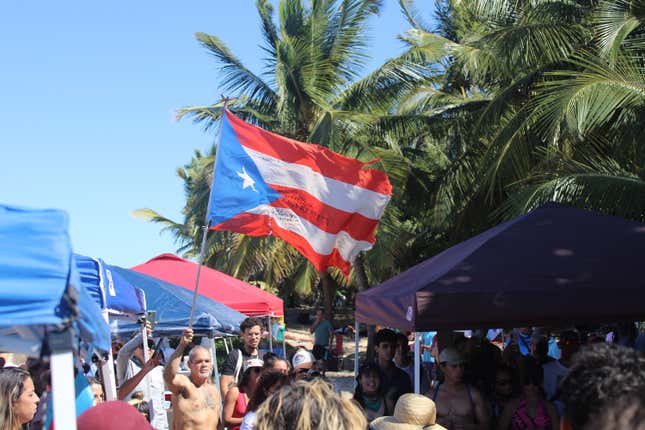
Many Puerto Ricans feel increasingly unwelcome on their own island as wealthy mainland Americans, social media influencers, and “crypto colonizers” flock to the tropical colony. Their response: Hold a massive beach party protest to remind newcomers that the beaches are for everyone.
Puerto Rico’s cost of living has soared in recent years, largely as the result of non-natives snatching up low-cost real estate in the wake of 2017's Hurricane Maria.
In July 2021, residents of the popular beach town Rincón joined with environmentalists to push back, demanding that a condo site stop construction of a pool that both cut off beach access and threatened endangered turtles that lay their eggs nearby.
The protests heated up this January, when a group of young beachgoers were accosted by wealthy homeowners who didn’t want them to set up a tennis court on the public beach. A video of the encounter went viral after it was shared by disgruntled Puerto Ricans, and in response, the community organized a beach protest at the end of January in Ocean Park. Weeks later hundreds of people attended another protest party, called “Ghetto Beach,” in Dorado.

Online videos of the protest parties feature people chanting “las playas son del pueblo” or “the beaches belong to the people,” and “yo soy Boricua, pa que tu lo sepas” which means “I’m Puerto Rican, just so you know.” There were sports tournaments along the beach, sunbathing, and dancing.
The beach party energy is fueled by years of frustration with monied newcomers, and policies that allow them to enjoy tax breaks and balmy weather, at the expense of people born and raised on the island.
“It’s kind of like if you’re not rich, your ability to take part or consume the natural resources of the island is significantly hindered,” said Carlos Berríos Polanco, a writer and lifelong Puerto Rican who has attended and written about the protests. “The only way that they were letting people through is if they stayed at these swanky expensive hotels.”

Polanco also says that not only are new homes closing off parts of beaches which are supposed to be open to the public, but they’re dangerously close to the water, and future flooding could cause waste water or litter to end up in the ocean, endangering marine life.
Other critics have also wondered how increased beachfront development could hurt local ecosystems as. In 2021, four members of Congress asked the U.S. Fish and Wildlife Service to declare a beach in Rincón a critical habitat for endangered leatherback and hawksbill sea turtles. Both species of turtles lay their eggs in that area of Puerto Rico, and overdevelopment along the coastline could would displace important nesting grounds.

In a statement, Rep. Nydia M. Velázquez (D-NY 7th), Rep. Steve Cohen (D-TN 9th), Rep. Alan Lowenthal (D-CA 47th), and Rep. Darren Soto (D-FL 9th) pointed out that the Puerto Rico Department of Environment and Natural Resources has reported that the beach often hosts about “20 sea turtle nests per season” and that some turtles and eggs had to be relocated from the area for their safety.
“DRNA notes that because of coastal erosion, Los Almendros beach is one of the few remaining beaches in the municipality where there is a sandy coastline suitable for hawksbill and leatherback turtles to nest,” the congress members wrote in their statement.

Tara DePorte, founder of the non-profit Human Impact Institute, points out that overdevelopment can present a variety of risks for fragile ecosystems and endangered marine species. DePorte previously conducted research on sea turtles in Barbados, and learned how development that brings extra car and foot traffic isn’t the only danger to the turtles.
“When they hatch, they go straight to the water, and a huge [problem] is light pollution. Light on land confuses the hatchlings… they’re programmed to know that the brighter thing is where they’re supposed to go,” DePorte said. “When there are too many lights in the other direction with development they go that way… they’re totally open for predators.”
More construction sites also mean dangerous runoff in nearby waterways, and runoff can harm nearby marine environments even if it’s non-toxic, DePorte said. “It can just be too much silt, that can do it. And to rebuild that [ecosystem] takes ages.”